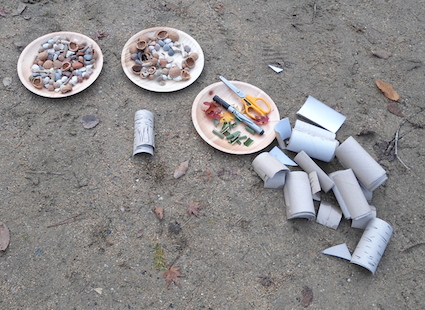At the International Skogsmulle Symposium in Japan there was an afternoon of playing games and undertaking practical activities such as making things with bamboo. This very simple memory game was featured and this is how it is played…

Firstly you prepare your “cups.” These are toilet rolls which have been quartered. Each one is decorated with black pens lines to make it look like birch bark. (It might be an interesting challenge for children to find any nearby birch trees to copy).
Next, the children need to gather objects to hide. This is a good opportunity for children to learn the concept of pairs. For each game, you need six pairs of objects which are small enough to be hidden under one of the “birch bark cups.” Alternatively you can just provide a range of these counters as illustrated in the above photo.

The board is created in the grit or woodland area. A chalk or stick square would work well too. Six pairs of objects are laid out in a square with the birch bark cups covering them. Then, just like the ordinary “Pairs” game, the children take turns to lift the cups two at a time to see if they have found a pair of objects. If they have, the objects are removed and kept. The winner is the person with the most objects.
What is nifty about this game is its ability to increase the challenge. When the objects are removed, the birch bark cups can be removed at the same time. Alternatively, they may stay in play so that the children turn over blank cups if they forget that the objects have been removed.
Finally like all good games, children should be encouraged to change the rules once they have learned them and enjoy making their own versions. Have fun!
Reflections
- This game is a simple adaptation of a commercial one. What games do you know which you could adapt for working well outside?
- Have you encouraged your children to invent nature games? Often this can happen spontaneously through play but sometimes a wee nudge is needed to get children’s imagination going. Playing a simple game like the one above can help illustrate this.
- How do you integrate nature games into the experiences you offer children? How effective is your approach? What alternatives or other ways exist that could better meet the needs of your children?
This blog post was originally published in February 2014.




















Looks fun and simple, we’ll give it a try!
Looks like a great game. Thanks for sharing at the Outdoor Play Party
For starters, are the squares independent of each other? So in square one, all 6 matches are in that square? Or could you find a match of an object in square one in square two? I suppose this could be a way to make the game harder? Also, do you recommend a starting age? I’m working some “Forest days” with an entire preschool. So I have 2 year olds and 5 sometimes almost 6 year olds, tho divided by age. In terms of not wanting to manage the set up or the kids too much, what age would you recommend using this? Also, I reckon in Japan they used bamboo instead of loo rolls? (You may have said this). Ta very much. Jim
Thanks Jim – I think in terms of an age for which it’s suitable, really it just depends on the interest from the child and a willingness to go with the flow – so the game may not happen in the traditional way – often 2yr olds just enjoy the “ta-dah” of lifting a toilet tube and seeing what’s underneath. And it may be you want a lot less pairs of items. Bamboo cut in half could work well, as could plant pots.
Thank you